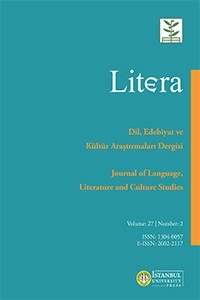Emotion as Sensation and Feeling in Maupassant’s La Peur
The argumentation process is not exclusive to non-fictional texts. On the contrary, it has coexisted with narrative since the early stages of human history. From an anthropological point of view, primitive societies imposed social prohibitions and laws through narrative discourses - such as myths - to avoid a possible crisis within society and to ensure homo sapiens survival. In considering the narrative aspect of the argument, it would be appropriate to assume that literary discourse can constitute a certain argumentative reality. This article seeks to discover and verify the way a character affects its extratextual reader through the argumentation process.In Guy de Maupassant’s La Peur, a group of soldiers discuss the true meaning of the emotion of fear: indeed, they argue about it. The ethos constructed by the storytelling character and his way of expressing his emotions leads us to discover how fear’s literary expression can metamorphose into different states, like sensation and feeling, for the sake of making the storyteller legitimate in his discourse. The methodology of this article is based on narrative, enunciative and discursive analyzes to identify the argumentative reality in Maupassant’s La Peur.
Keywords:
Argumentation, emotion, sensation, feeling ethos,
___
- Amossy, R. (2010). La presentation de soi, Ethos et identite verbale. Paris : Presses Universitaires de France. google scholar
- Centre National de Ressources Textuelles et Lexicales. (2005). Acces par : https://www.cnrtl.fr/definition/%C3%A9motion. https://www.cnrtl.fr/definition/sensation. google scholar
- Charaudeau, P. (2000) La pathemisation a la television comme strategie d’authenticite. Les emotions dans les interactions. Lyon : Presses universitaires de Lyon. google scholar
- URL: http://www.patrick-charaudeau.com/La-pathemisation-a-la-television.html. google scholar
- Charaudeau, P. & Maingueneau, D. (2002). Dictionnaire d’analyse du discours. Paris : Editions du Seuil. google scholar
- Debat, G. (2019). Les emotions en sciences humaines et sociales. Seminaire mensuel transversal des doctorants de Framespa - Histoire des emotions. google scholar
- https://hal.archives-ouvertes.fr/hal-02331246/document#:~:text=%C3%89tymologiquement%2C%20 %C3%A9motion%20vient%20de%20%C3%A9,une%20conduite%20r%C3%A9active%2C%20un%20 r%C3%A9flexe. google scholar
- Descartes, R. (1995). Discours de la methode. Paris : Bookking International. google scholar
- Elouni, N. (2018). Etude de quelques formes d’expression des emotions et des sentiments dans le contexte des nouvelles formes de communication. (These de doctorat) Archives Ouvertes. l’Universite de Bourgogne Franche-Comte, Dijon. (NNT : 2018UBFCH026). google scholar
- Genette, G. (1972). Figures III. Paris : Editions du Seuil. google scholar
- Hekmat, I., Raphael, M., Rabatel, A. (2013) L’emotion argumentee autour des identites dans Les genres mediatiques. Le discours et la langue. Revue de linguistique française et d’analyse du discours. EME editions, 2012, Tome 4.1. pp. 7-18. google scholar
- Leavitt, J. (2005). Le mythe aujourd’hui. Anthropologie et Societes. Volume 29. Numero 2. p. 7-20. google scholar
- Maingueneau, D. (2001). Pragmatique pour le discours litteraire. Paris : Lettres SUP. Nathan. google scholar
- Maupassant. (2005). La Peur. Contes de la Becasse. Edition electronique du groupe « Ebooks libres et gratuits ». https://www.ebooksgratuits.com/details.php?book=750. google scholar
- Niziolek, M. (2017). Les procedes de l’intensification de la peur dans la litterature fantastique. Synergies Pologne n° 14, 93-105. google scholar
- Rabatel, A. (2004). Argumenter en racontant. Bruxelles : De Boeck. google scholar
- Victorri, B. (2002). Homo narrans : le röle de la narration dans l’emergence du langage. Langages n.146, 112-125. google scholar
- Başlangıç: 1954
- Yayıncı: İstanbul Üniversitesi
